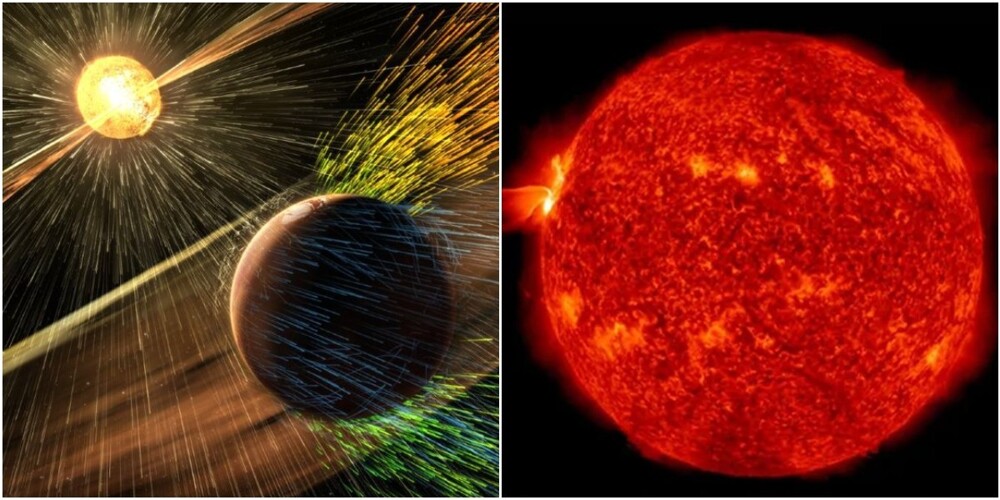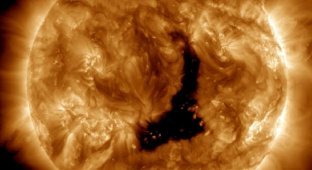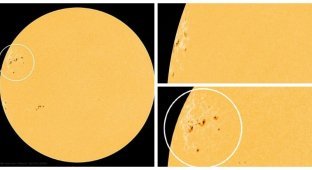10 interesting discoveries about the Sun for 2023 (11 photos)
In addition to the fact that the Sun is the largest object in the solar system, it is also one of the most mysterious formations in outer space. We are constantly learning new things about the star called the Sun, and 2023 is no exception. From a surprisingly active solar cycle to powerful flares, we learn about the 10 most interesting discoveries about the Sun made by scientists in 2023. 
1. The sun is approaching its highest activity 
The main news of this year is that the Sun is actively approaching the main peak of its activity. Experts believe that this peak will be powerful and even “explosive.” At the start of the current solar cycle in 2019, scientists predicted that solar maximum would occur sometime in 2025 and would be relatively weak compared to previous ones. However, many factors early in the year, including an increase in sunspot numbers, powerful X-class solar flares and changes in Earth's upper atmosphere, point to the opposite. When this solar peak arrives, you can expect more solar storms: this will lead to frequent auroras, radio outages, problems with satellites, and may also affect the migration of some animals.
2. The sun is smaller than previously thought 
This year, scientists also proved that the outer part of the solar atmosphere (solar corona) does not extend as far as previously thought. This conclusion was made by measuring the vibrations that pass through the corona. The difference between the new and previous results is relatively small: the Sun is most likely 0.03-0.07% smaller than previously thought.
3. The Sun also has its own “aurora” 
A study conducted in November 2023 found that the Sun also has auroras - although they are slightly different from those we see on Earth. Astronomers have discovered that the aurora on the Sun is caused by electrons that are accelerated to incredibly high speeds by it. They saw such a light show over a sunspot. The frequencies of radio waves from this aurora were very similar to those emitted by the aurora on Earth.
4. The most powerful solar storm 
In October 2023, researchers discovered that a massive solar storm known as the Miyake Event occurred about 14,000 years ago. Experts say it could be the most powerful solar storm ever to hit Earth. They analyzed fossilized trees they found in the French Alps - and revealed a high spike in radiocarbon levels that occurred 14,300 years ago.
5. Solar superflares could become the source of life on Earth 
A May 2023 study found that energy from superflares on the Sun could have triggered the emergence of life on Earth billions of years ago. During the study, scientists found that high-energy particles that arise due to solar flares, when colliding with gases in the Earth's atmosphere, could form amino acids and carboxylic acids - and these are the main building blocks of proteins and all organic life.
6. The Sun Can Store Dark Matter Particles 
This year, scientists discovered that there may be hidden particles of dark matter (a mysterious substance that fills the Universe and does not participate in electromagnetic interactions) inside the Sun. And the answer may lie in neutrinos - subatomic “ghost particles” emitted by the Sun. Researchers have suggested that the Sun's core may have a high concentration of dark matter, and if so, it will periodically emit slightly more neutrinos than usual.
7. Solar cycles were shorter in the past 
Currently, one solar cycle is about 11 years: during this time, the Sun moves from solar minimum to solar maximum and back. But in June, scientists published a paper suggesting that cycles may have been much shorter in the past. They studied ancient texts, founddata from Korea, which detail solar phenomena during the period of reduced solar activity between 1645 and 1715. They found that solar cycles at this time lasted only eight years.
8. "Heartbeat" in the Sun 
For more than a decade, scientists have speculated about the origins of the mysterious heartbeat-like radio pulses that come from the Sun during solar flares. When viewed on a graph, these pulses are similar to an electrocardiogram because the signal fluctuates. Scientists determined that the source of these radio bursts came from a solar flare at an altitude of more than 5,000 km above the surface of the Sun. Earlier this year, they also studied some similar pulses seen during a solar flare in 2017. They found that these pulses originated from oscillations in electric current fields that pass through plasma loops on the Sun's surface.
9. 
In July, astronomers saw “shooting stars” on the Sun for the first time. They are clumps of plasma that fall onto the surface of the Sun - like meteorites falling to Earth. The diameter of such clumps can reach 700 kilometers. Scientists called this phenomenon coronal rain.
10. Scientists have discovered jets that may be responsible for solar wind 
In August, the European Space Agency's Solar Orbiter discovered tiny jets of plasma rising from dark regions (coronal holes) in the solar corona. These jets are smaller than others, but they are quite powerful. Scientists have suggested that the energy of these jets can “launch” gusts of solar wind.

























